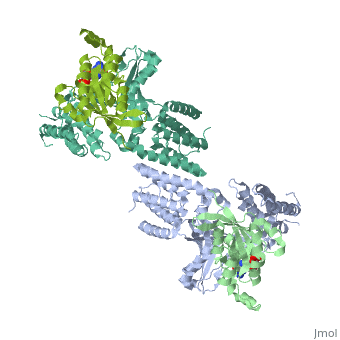2wmn
From Proteopedia
Structure of the complex between DOCK9 and Cdc42-GDP.
Structural highlights
FunctionDOCK9_HUMAN Guanine nucleotide-exchange factor (GEF) that activates CDC42 by exchanging bound GDP for free GTP. Overexpression induces filopodia formation.[1] [2] Evolutionary ConservationCheck, as determined by ConSurfDB. You may read the explanation of the method and the full data available from ConSurf. Publication Abstract from PubMedActivation of Rho guanosine triphosphatases (GTPases) to the guanine triphosphate (GTP)-bound state is a critical event in their regulation of the cytoskeleton and cell signaling. Members of the DOCK family of guanine nucleotide exchange factors (GEFs) are important activators of Rho GTPases, but the mechanism of activation by their catalytic DHR2 domain is unknown. Through structural analysis of DOCK9-Cdc42 complexes, we identify a nucleotide sensor within the alpha10 helix of the DHR2 domain that contributes to release of guanine diphosphate (GDP) and then to discharge of the activated GTP-bound Cdc42. Magnesium exclusion, a critical factor in promoting GDP release, is mediated by a conserved valine residue within this sensor, whereas binding of GTP-Mg2+ to the nucleotide-free complex results in magnesium-inducing displacement of the sensor to stimulate discharge of Cdc42-GTP. These studies identify an unusual mechanism of GDP release and define the complete GEF catalytic cycle from GDP dissociation followed by GTP binding and discharge of the activated GTPase. Activation of Rho GTPases by DOCK exchange factors is mediated by a nucleotide sensor.,Yang J, Zhang Z, Roe SM, Marshall CJ, Barford D Science. 2009 Sep 11;325(5946):1398-402. PMID:19745154[3] From MEDLINE®/PubMed®, a database of the U.S. National Library of Medicine. See Also
References
| ||||||||||||||||||||


